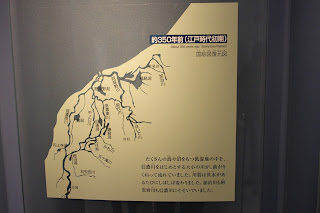As part of the IFAS training at ICHARM, we participated in a field trip to Shinano river. Shinano river, on the North West coast of Japan, is the longest of Japan with 367 km. It also has the third largest catchment area with 11,99 km2, following Tone and Ishikari river. In sharp contrast with Tone river in the Kanto area, the population in the river basin is 2.9 million, about half of which live in Nagano prefecture and half in Niigata prefecture. Niigata prefecture is famous for rice and the main rice producing area of Japan.
The first place we visited in Niigata was the Shinano River Oukouzu museum, which explains about the Oukouzu diversion channel. This channel was built in response to the heavy floods and lies roughly in between the cities Nagaoka and Sanjo. There were plans to create a channel since the early 1700s, but it took several more floods for the plans to be accepted. In 1869 construction started and in 1931 the channel was completed. Below you can see the historical coastline of Niigata prefecture, a model of the dam situation and the actual dam with a fish ladder.
Secondly we visited Niigata city, on the coast of Niigata prefecture where Shinano river meets the ocean. At the top of the Toki Messe building we had a good view of the river and the city, and even Sado island just off the coast.








No comments:
Post a Comment